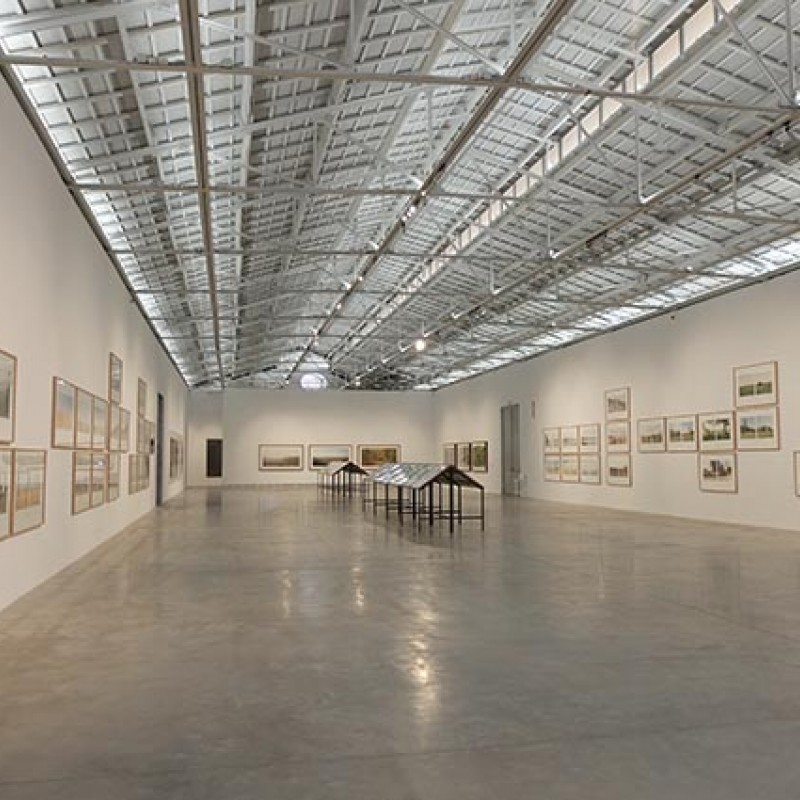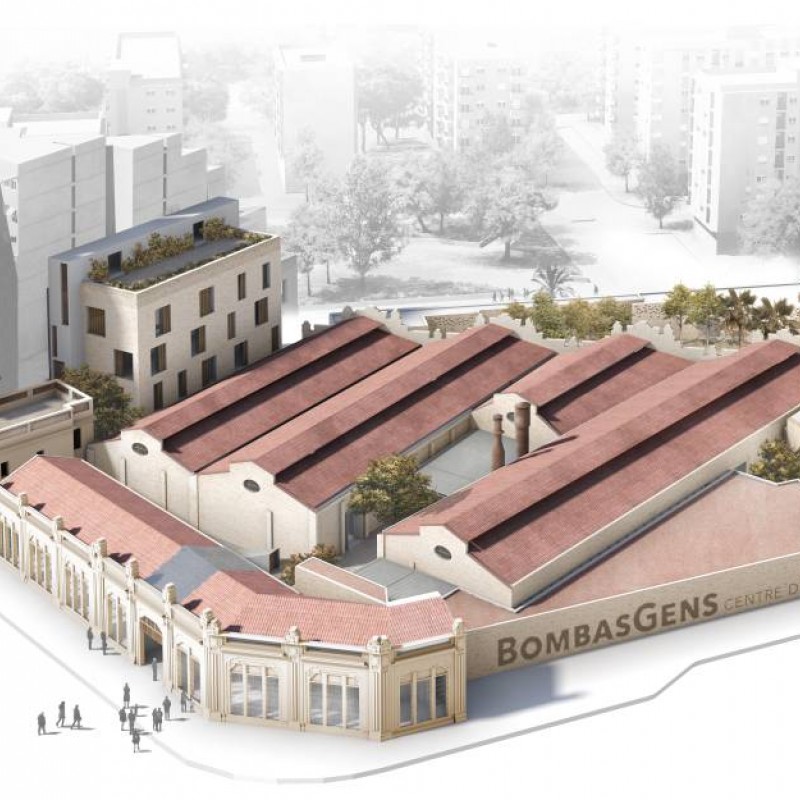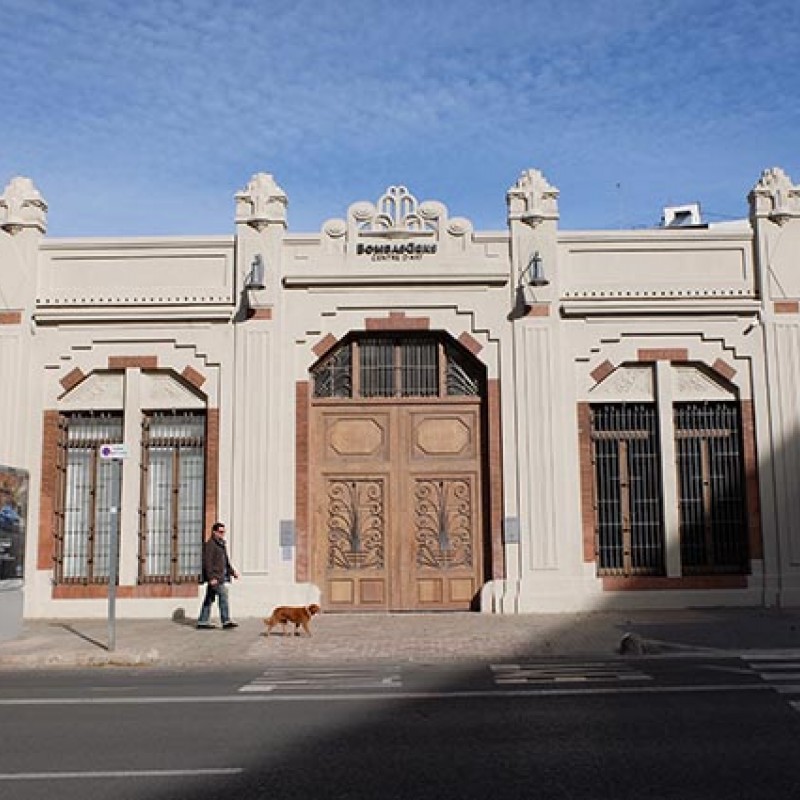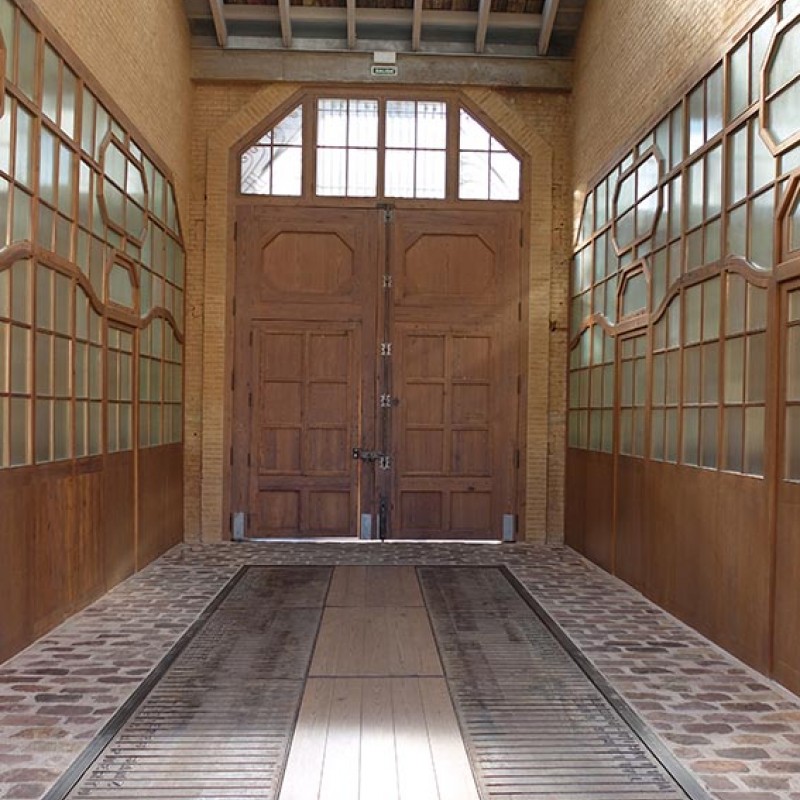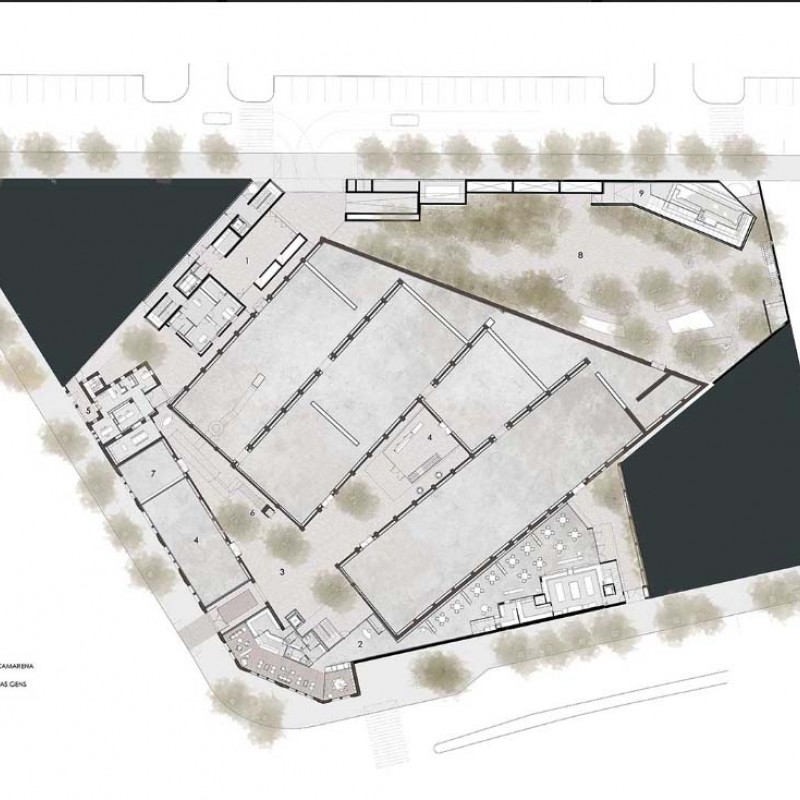Bombas Gens
Av. de Burjassot, 54-56, 46009 València, Spain
| Former Use: | Hydraulic pumps factory | 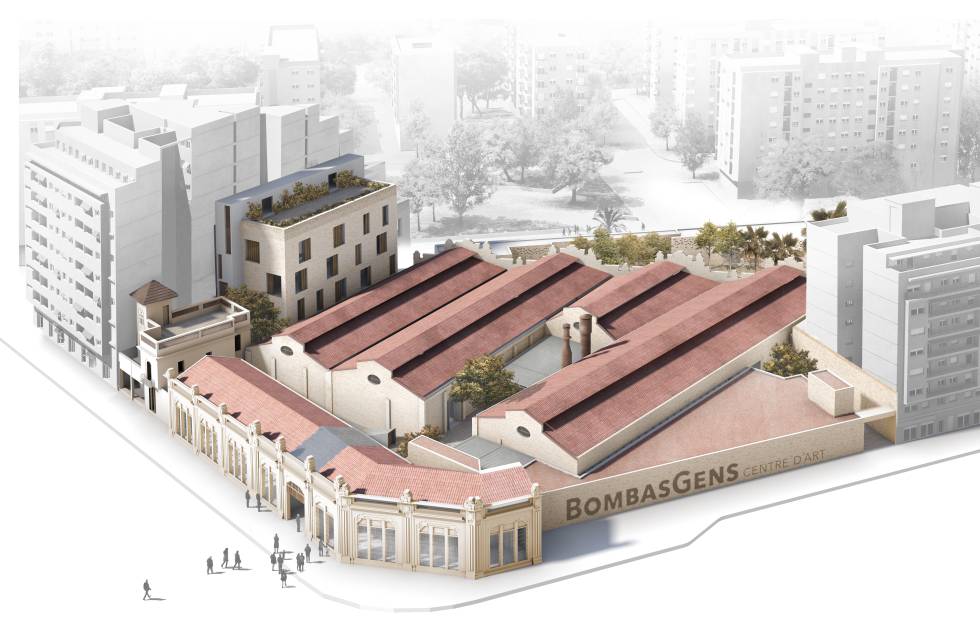 |
| New Use: | Cultural centre, restaurant, community support day centre | |
| Category: | Community centre, Culture, HoReCa, Recreation | |
| Website: | http://www.bombasgens.com/en/ | |
| Original Architect: | Cayetano Borso di Carminati | |
| Reuse Architect: | Eduardo de Miguel, Annabelle Selldorf ang Ramón Esteve | |
| Construction year(s): | 1930 - | |
| Reuse year(s): | 2017 - 2018 |
Description:
Historic use
Bombas Gens was built in 1930 as a factory for the manufacturing of small agricultural machinery, industrial valves and hydraulic pumps. It is located in the northern part of the centre of Valencia, at the district Marxalenes; a developing rural area which was at the outskirts of the city at the time of the factory’s construction. Aiming for a prominent and innovative industrial unit, the founders of the factory Carlos Gens Minguet and Rafael Dalli, commissioned the design to the renowned valencian architect Cayetano Borso di Carminati. The complex is nowadays regarded as one of the most important examples of art deco architecture in Valencia. Besides its high aesthetical value, the former factory is also distinguished for its advanced provisions for the workers facilities.
Bombas Gens was comprised of four production halls, an administration and showroom building and the manager’s residence, the facades of which were richly decorated. The interior set-up of the factory was influenced by the evolution of the machinery, resulting in multiple expansions and renovations. Apart from the shifts in mechanisation, historic developments also influenced the industrial unit. During the Spanish Civil War the factory was requisitioned by the Republicans. In that period the production shifted from hydraulic pumps to ammunition while an air raid shelter was built (c. 1938) for the protection of the work-force. Around 1960, a fifth production hall was added to the complex that stayed in use only for three decades. In 1991 Bombas Gens ceased operations.(Bombas Gens Centre d'Art, n.d.)
Reuse Preparation
For more than two decades, albeit the protests of the local community, the complex remained abandoned to deteriorate. The indifference of the owners as well as the absence of a legal protection status left it exposed to repeated actions of vandalism. The 2000s saw Bombas Gens flirting with destruction when a plan for the demolition the historic structure and its replacement with a hotel, parking and commercial complex was submitted to the City Council. The financial crisis had a nuanced impact on the complex, stalling the destructive plan yet prolonging its evolving decay. The downward spiral of the former industry culminated in 2014 when a fire destroyed the administration building’s roof. (Vásquez, 2014)
A change in ownership put an end in the deterioration of the complex, marking the beginning of its revitalisation. On September 19, 2014 the site was acquired by Sancana Gestión de Inversiones S.L., which also took over its transformation. The new proposed plan for the obsolete factory involved its conversion into a venue for the cultural, social and research activities of the newly established Fundació Per Amor a l'Art (FPAA), created by the family of the new owners. The cost of the project, estimated between 9 to 10 million euro, was fully covered by the owners’ private funds. (Bono, 2017) According to Suzana Lloret, General Director FPAA, the Foundation showed interest in the complex for the singularity of its architecture and the urgency for its safeguarding.(Fundació Per Amor a l'Art, n.d.) Moreover, the size, spatial characteristics, setup and the legal status of Bombas Gens as well as its location in an area with very limited artistic facilities were additional reasons for converting it into the headquarters of the Foundation. (interviews, November 2017)
Reuse process
The rehabilitation of the complex which started in 2015 prioritised the preservation of both the tangible and the intangible values of the industrial site. The interdisciplinary group of specialists involved in that phase, including architects, civil engineers, archaeologists, conservationists et.al. realised a meticulous transformation, taking into account the standing international industrial heritage conservation and reuse principles.
The process started with the structural consolidation of the complex and the rehabilitation of its roofs. Special attention was payed into the conservation of the main façade which was the only element protected at the time. The typology, form and materials of the historic industrial architecture were respected while the industrial character of the complex was largely preserved. Ramon Esteve, the architect responsible for the redesign of the site explains:
“Ceramic brick and galvanised steel are the most used materials because they evoke the original industrial atmosphere of the complex.” (Ramon Esteve Architecture Design, n.d.)
According to the testimonies of the specialists involved in the transformation process (interviews, November 2017), all pieces of machinery that had escaped the liquidation of 1991 and the thefts of the 1990s and 2000s, were maintained and reintegrated in the new set-up. However, this assertion appears to be only partially consistent with the analysis’ results of the documentation of the complex before its transformation. As shown in the pictures XX, certain parts of the factory’s machinery were sacrificed during the reuse of Bombas Gens.
The interventions that followed the consolidation phase, in their largest extend did not jeopardise the integrity of the former factory. The demolitions were restricted to later additions, such as the production hall of the 1960s and some sheds, leaving the original core of the factory intact. The new additions included a new building in the northwest part of the complex’s plot and a glass cubicle housing the reception of the Art gallery. Other interventions involved the interior remodelling of the administration and dwelling unit as well as minor modifications in the internal facades of the complex.
A challenging aspect of the new programme was its requirements for large parking and storage spaces. The construction of these facilities underground, albeit more expensive met the posed challenge without compromising the structure and morphology of the historic complex. During the excavations for the creation of the abovementioned spaces, the Civil War shelter as well as a 15th century cellar were discovered. In that phase, according to the testimonies of the experts and staff members of the Foundation (interviews, November 2017), the attitude of the owners played a decisive role. Paloma Berrocal, director of archaeological and historic intervention of the Art Centre Bombas Gens, states:
“Sometimes the owners were more sensitive and conservative than us about the handling of the original elements. For example, when we discovered the civil war shelter and the cellar, we informed them and they showed great interest in preserving and integrating them in the project, despite coming as a surprise.” (interview, 6/11/2017)
Simultaneously with the regeneration of the complex, Bombas Gens’ administration set in motion a process of connection with the local community. According to Sonia Martinez, coordinator of educational and cultural activities of Bombas Gens Art Centre (interview 7/11/2017), various lines of action were organised for turning the locals into partakers in the transformation project. Such activities involved guided tours in the construction site, informational meetings, brainstorming sessions for ideas of potential collaborative action and organisation of cultural events inviting the public to visit Bombas Gens before its official inauguration. Moreover, in that period a documentation process of oral testimonies of former workers and neighbours took place, serving both as a participation action and as a method of safeguarding the intangible heritage aspects of the factory.
The attention drawn to the project in that early phase along with the meticulous transformation strategy acted as a means of pressure to the Local authority. As a result, in 2016 the protection status of the historic industry was upgraded. Since then, the whole complex has been listed as a monument of Local Interest, whereas in the past the protection inscription covered only the façade of Burjassot avenue.(Zafra, 2016)
Operation
The revived Bombas Gens complex opened its doors again in the summer of 2017 and it quickly became a point of reference. From the outset, its vibrant and diverse activity offered to the public free of charge, attracted a big audience of different ages and social status. The new program of that first delivery phase was composed of three distinct functions: an art centre which houses the collection of visual arts of the Foundation, stretching in the four former production halls, the administration facilities of the FPAA housed in the former residential unit and a high-end restaurant occupying the former administration building of the factory.
An additional asset of the program, was the establishment of the exhibition “Historias of Bombas Gens” in the former showroom of the factory. This impressive piece of work, serves as an interpretation centre for the history of the site, projecting its original architectural, technical and social values. Furthermore, it provides a concise and comprehensive view of the complex’s transformation process. Enriched with the result of the documentation of oral testimonies realised during the transformation of the complex, it also provides a kaleidoscopic vision of the various facets of the factory over time. Combining different sources of information, including drawings, text, photographs, objects and audio-visual material, the exhibition captures and disseminates the role, essence and past activity of Bombas Gens while safeguarding its intangible inherited values.In the operation phase, the FPAA continued collaborating with experts of different fields, a decision which had been proven particularly beneficial in the preliminary stage of the project. Moreover, highly skilled professionals with extended relevant experience in prestigious art institutions, were incorporated to the staff. The sound collaboration of the stakeholders and the good use of the expertise of the involved parties by the owners strengthened the project.
Furthermore, the social outreach and inclusion activities which started during the restoration and reuse phase have been enriched after the official inauguration of the complex. Links with various local educational institutions have been established, providing opportunities for joined action while a rich array of social activities offered to the public for free are organised on a weekly basis. According to Sonia Martinez (interview, 7/11/2017) upon the delivery of the second phase, new links will also be formed between the various lines of action of the Foundation.
The second phase of Bombas Gens transformation project is planned to be delivered in stages within 2018. The artistic, administration and recreation core of the first phase will be complemented with the opening of the restored cellar and Civil War shelter and the addition of a garden at the north-eastern part of the plot and a new building. The later will house the social and research activities of the Foundation, including a Community support day centre for children and teenagers in risk of social exclusion and also the Wilson team Coordination centre, dedicated to research and awareness over Wilson’s disease and other rare illnesses.
Relevant Literature:
- Bombas Gens Centre d'Art. n.d. History [Online]. Available: http://www.bombasgens.com/en/building/history/ [Accessed 22/3/2018].
- Bono, F. 2017. Una Antigua fábrica de bombas producirá arte y solidaridad El país 16/4.
- Fundació Per Amor a l'Art. n.d. Edificio [Online]. Available: http://fpaa.es/edificio/ [Accessed 23/3/2018].
- Ramon Esteve Architecture Design. n.d. Bombas Gens: Art, Scientific Research and Social Project [Online]. Available:
http://www.ramonesteve.com/en/pro/architecture-en/culture-and-education/bombas-gens/ [Accessed 26/03/2018]. - Vásquez, C. 2014. Un incendio destroza la cubierta del edificio modernista Bombas Gens. El país 5-2.
- Zafra, I. 2016. Valencia protege Bombas Gens, sede de un nuevo centro de arte. El país 29-1.
